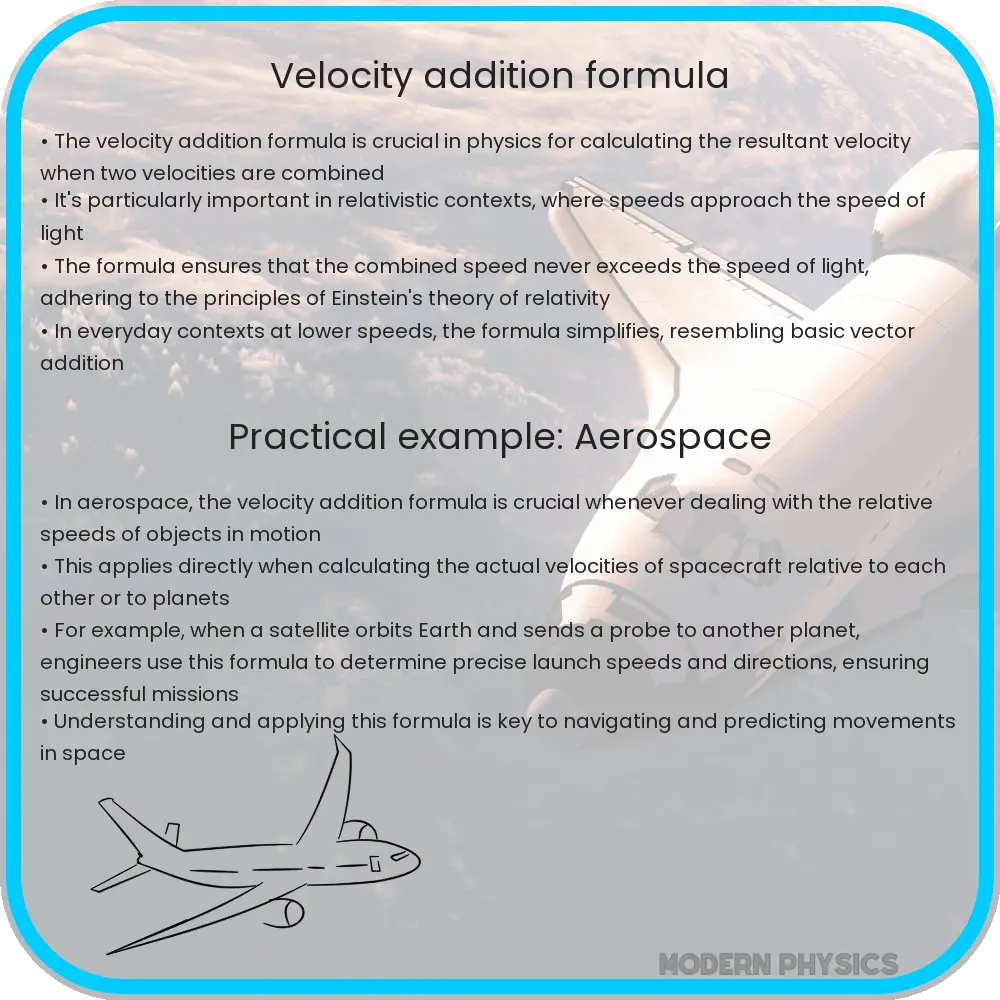Explore the Velocity Addition Formula in relativity, its implications on motion near light speed, and its role in modern physics and cosmic phenomena.

Understanding the Velocity Addition Formula in Relativity
In the realm of physics, particularly in the study of relativity, the concept of velocity addition plays a crucial role in understanding how speeds combine when dealing with objects moving close to the speed of light. This article delves into the fascinating world of velocity addition in the context of Einstein’s theory of relativity, exploring the limitations and peculiarities of motion at high speeds.
The Classical View: Newtonian Mechanics
Traditionally, in Newtonian mechanics, velocities simply add up. If an object A moves at a velocity \( v_1 \) relative to object B, and B moves at a velocity \( v_2 \) relative to a third object C, the velocity of A relative to C is the sum \( v_1 + v_2 \). This linear addition works well at everyday speeds but fails to accurately predict outcomes when the speeds involved approach the speed of light.
Relativity and the Speed of Light
Enter the world of Albert Einstein’s Special Theory of Relativity, which revolutionized the way we understand motion at high speeds. According to relativity, the speed of light in a vacuum, denoted as \( c \), is the ultimate speed limit in the universe and remains constant regardless of the observer’s motion. This constancy leads to some non-intuitive consequences, especially when it comes to adding velocities.
The Velocity Addition Formula
The formula for adding velocities in the framework of special relativity, known as the relativistic velocity addition formula, is given by:
\[ v = \frac{v_1 + v_2}{1 + \frac{v_1 \times v_2}{c^2}} \]
Here, \( v \) is the resultant velocity, \( v_1 \) and \( v_2 \) are the velocities to be added, and \( c \) is the speed of light. This equation ensures that no matter how fast \( v_1 \) and \( v_2 \) are, as long as they are less than \( c \), the resultant velocity \( v \) will also always be less than \( c \).
This formula has profound implications. For instance, if two objects are moving towards each other, each at a speed of 0.9c relative to a stationary observer, their speeds don’t simply add up to 1.8c. Instead, using the velocity addition formula, the relative velocity is found to be less than the speed of light, in line with the principles of relativity.
Implications of the Velocity Addition Formula
The relativistic velocity addition formula not only sets a universal speed limit but also introduces fascinating phenomena such as time dilation and length contraction. In relativity, as an object approaches the speed of light, time slows down and lengths contract along the direction of motion. This is a direct consequence of the nature of space-time as described by Einstein’s theories. The faster an object moves, the more pronounced these effects become, further reinforcing the impossibility of surpassing the speed of light.
Experimental Verification and Applications
The predictions of the velocity addition formula have been confirmed through numerous experiments. One of the most famous is the observation of muons produced in the Earth’s atmosphere. These subatomic particles, moving close to the speed of light, have a lifespan that is significantly extended due to time dilation, allowing them to reach the Earth’s surface, a phenomenon that can be accurately predicted using relativistic principles.
Furthermore, the formula is crucial in fields like particle physics, where particles are accelerated to speeds close to that of light. Understanding how velocities add up at these extreme speeds is essential for predicting the outcomes of particle collisions and interactions in particle accelerators like the Large Hadron Collider.
Challenges and the Quest for Deeper Understanding
Despite its successes, the relativistic velocity addition formula also highlights the challenges in unifying general relativity with quantum mechanics. The formula works well at macroscopic scales and high velocities, but integrating it with the quantum world remains one of the major quests in theoretical physics.
Conclusion
The relativistic velocity addition formula is a cornerstone of modern physics, encapsulating the revolutionary ideas of Einstein’s relativity. It not only constrains the speed of objects to below the speed of light but also introduces a new way of thinking about space, time, and motion. Its implications extend from the cosmic scale, affecting the motion of galaxies, down to the subatomic world, influencing the behavior of particles in accelerators. As we continue to explore the universe, both vast and minuscule, the principles encapsulated in this formula guide us in understanding the fundamental nature of reality.
